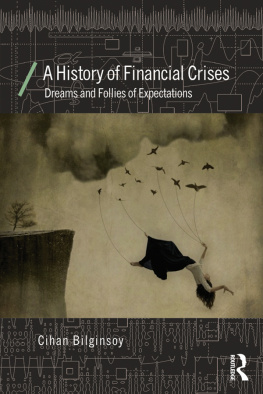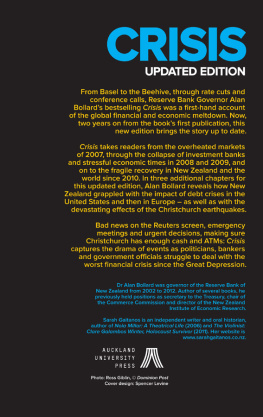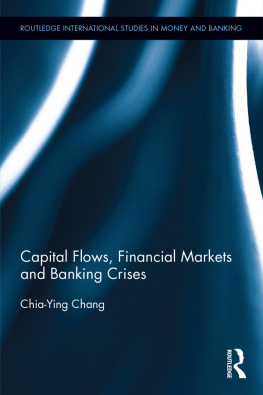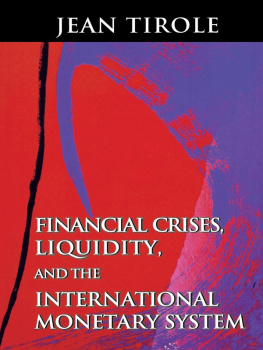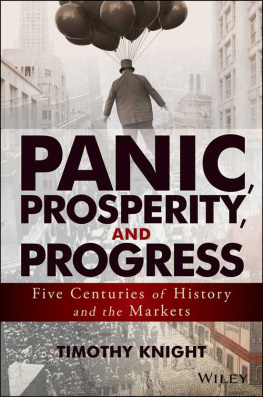Cover art: Let Nature Catch You by Tara Minshull. Photograph from her Cinematic Worlds collection.
is reproduced from Earl A. Thompson, The Tulipmania: Fact or Artifact, Public Choice , 130(1) (2007), p. 101, Figure 1. Copyright 2007 Springer. Reprinted by permission of Springer Science and Business Media.
is based on data from Antoin E. Murphy, John Law: Economic Theorist and Policy-Maker . Clarendon Press (1997). Copyright Antoin E. Murphy. Reprinted by permission of Oxford University Press.
are based on data from Arthur G. Gayer, W.W. Rostow and Anna Jacobson Schwartz, The Growth and Fluctuations of the British Economy 17901850: An Historical, Statistical, and Theoretical Study of Britains Economic Development . Oxford University Press (1953). Reprinted by permission of Oxford University Press.
, fixed investment data are from B.R. Mitchell, The Coming of Railway and United Kingdom Economic Growth, The Journal of Economic History , 24(3) (1964). Copyright1964 The Economic History Association. Reprinted by permission of Cambridge University Press.
is based on data from Benjamin Horace Hibbard, A History of the Public Land Policies . University of Wisconsin Press (1965). CopyrightRegents of the University of Wisconsin. Reprinted by permission of the University of Wisconsin Press.
are based on data from Susan B. Carter, Scott Sigmund Gartner, Michael R. Haines, Alan L. Olmstead, Alan L. Richard Sutch and Gavin Wright (eds) The Historical Statistics of the United States, Millenial Edition (2006). Copyright2006 Cambridge University Press. Reprinted by permission of Cambridge University Press.
is from Walter Buckingham Smith and Arthur Harrison Cole, Fluctuations in American Business 17901860 , pp. 1845, Harvard University Press (1935). Copyright1935 by the President and Fellows of Harvard College. Reprinted by permission of the publisher.
are based on data from NBER Macrohistory Database Online . Reprinted by permission.
(in part) are based on data from S&P Dow Jones. The S&P 500 index and the Dow Jones Industrial Average are proprietary to and are calculated, distributed, and marketed by S&P Opco, LLC (a subsidiary of S&P Dow Jones Indices LLC), its affiliates and/or its licensors and has been licensed for use. S&P and S&P 500 are registered trademarks of Standard & Poors Financial Services LLC, and DJIA, Dow Jones Industrial Average, and Dow Jones are registered trademarks of Dow Jones Trademark Holdings LLC. 2014 S&P Dow Jones Indices LLC, its affiliates and/or licensors. All rights reserved. Reprinted by permission.
are based on Robert J. Shillers online data. Reprinted by permission.
(in part) is based on data from NASDAQ Indices. Reprinted by permission.
Reprinted by permission.
(in part) and 16.2 are based on data from FRED, Federal Reserve Bank of St. Louis. LIBOR data are used by permission of ICE Benchmark Administration.
Adjustable rate mortgage Mortgage with a variable interest rate that changes with credit-market conditions.
Adverse selection Outcome of asymmetric information in which too many low-quality and too few high-quality market goods, assets, or factors are traded.
Agency-label security Mortgage-backed securities issued by GSEs.
Allais paradox Paradox that shows the inconsistency of observed individual choices with predictions of expected utility theory.
Allocative efficiency Allocation of resources in which the quantities of commodities produced are in accordance with demand. It is achieved when the benefit obtained from the last unit is equal to the cost of producing the last unit.
Alternate-A (Alt-A) loan Loan that is riskier than a prime loan, due to factors such as deficient documentation and unsteady income, but less risky than a subprime loan.
Animal spirits Human attribute that explains decisions as outcomes of spontaneous urges to act rather than probabilistic expectations (according to Keynes).
Annuity Financial contract whereby one party makes a contribution or a loan to another party in return for receiving periodic payments over a period of time (historically, the latter have been as long as 99 years).
Arbitrage Simultaneous purchase and sale of an asset (or equivalent assets) in order to profit from price differences across markets. (See: Law of one price)
Aspirations gap Difference between the standard of living to which individuals or households aspire and the current standard of living.
Asymmetric information Situation in which one side of the transaction knows more than the other.
Attention cascade Tendency of individuals or the media to focus on a particular story for a long period of time.
Availability heuristic Tendency in decision-making to put more weight on readily available information rather than consider alternatives.
Banknote Paper currency issued by banks and originally backed by specie.
Bank run Sudden demand by a large number of banknote holders, depositors, or short-term lenders to withdraw their funds from banks.
Bill of exchange Written note whereby one party (drawer or issuer) promises to pay a specified sum of money to a counterparty (payee) at a fixed time or on demand. (See: Promissory note)
Bimetallism System in which both gold and silver are used as monetary standards.
Bond Debt instrument sold by the issuer (corporation, government) in order to borrow funds. The issuer is obliged to pay the bondholders (creditors) the coupon value periodically and the face value when the bond matures.
Bounded rationality State in which a decision problem cannot be clearly delineated due to informational, computational, and cognitive limitations and people base their decisions on a bounded set of choices and accept satisfactory solutions rather than the optimal. (See: Economic rationality, Satisficing)
Bretton Woods system Post-World War II international monetary system based on gold-exchange standard.
Call (buy) option Contract whereby one party buys the right (but not the obligation) to buy an asset at a certain price (strike price) before or at a specific date (exercise date).
Capital gain/loss Difference between an assets current sale price and the initial purchase price.
Capital market Market where equities and long-term debt instruments are traded.
Cash settlement Settlement of a derivative (futures, options, swap) contract by cash transfer of the profit or loss amount rather than physical delivery. (See: Physical settlement)
Certainty effect Tendency to prefer a less risky (more certain) outcome even when its (probabilistic) expected value is lower than the alternative.
Chartism Investment strategy based on forecasting the future behavior of prices from their historical patterns. (See: Technical analysis)
Circuit breaker Measure designed to stop trading when the market index falls below a threshold.
Clearing house Agency for settling claims and accounts, including check payments and futures and options trades, among member financial agents.
Cognitive dissonance Peoples tendency to ignore, reject, avoid, or explain away new information that contradicts their belief system.
Collateral Assets pledged by a borrower to a lender as security for repayment of a loan that are seized by the lender if the borrower defaults.
Collateralized debt obligation Structured security backed by the cash flow of mortgage-backed securities and other asset-backed securities.
Collateralized mortgage obligation Structured security backed by the cash flow of mortgage-backed securities.

